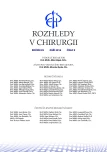Corpus alienum – migrating foreign body
Authors:
L. Sojka
Authors‘ workplace:
Chirurgická klinika 1. LF Univerzity Karlovy, Thomayerova nemocnice v Praze, přednosta: doc. MUDr. J. Šimša, Ph. D.
Published in:
Rozhl. Chir., 2016, roč. 95, č. 9, s. 373-376.
Category:
Case Report
Overview
Our case study presents a case of foreign body migration through the vascular system of the human body. The following paper is a comprehensive overview of different diagnostic approaches, extraction indications, common ways in which a foreign body can migrate via the vascular system and possible complications caused by the migration or extraction of the foreign body.
Keywords:
foreign object – extraction − migration
Sources
1. Capellan O, Hollander JE. Management of lacerations in the emergency department. Emerg Med Clin North Am 2003;21 : 205−31.
2. Capellan O, Hollander JE. Management of lacerations in the emergency department. Emerg Med Clin North Am 2003;21 : 205–31.
3. Valente JH, Forti RJ, Freundlich LF, et al. Wound irrigation in children: saline solution or tap water?. Ann Emerg Med 2003;41 : 609–16.
4. Fernandez R, Griffiths R, Ussia C. Water for wound cleaning. Cochrane Database Syst Rev 2002:CD003861.
5. Roberts JR, Hedges JR. Clinical procedures in emergency medicine. 4th ed. Philadelphia, Saunders 2004.
6. DeBoard RH, Rondeau DF, Kang CS, et al. Principles of basic wound evaluation and management in the emergency department. Emerg Med Clin North Am 2007;25 : 23−39.
7. Anderson MA, Newmeyer WL 3rd, Kilgore ES Jr. Diagnosis and treatment of retained foreign bodies in the hand. Am J Surg 1982 : 144 : 63−7.
8. Levine MR, Gorman SM, Young CF, et al. Clinical characteristics and management of wound foreign bodies in the ED. Am J Emerg Med 2008;26 : 918−22.
9. Eylon S, Mosheiff R, Liebergall M, et al. Delayed reaction to shrapnel retained in soft tissue. Injury 2005;36 : 275−81.
10. Pfaff JA, Moore GP. Reducing risk in emergency department wound management. Emerg Med Clin North Am 2007;25 : 189−201.
11. Brook JW. Management of pedal puncture wounds. J Foot Ankle Surg 1994,33 : 463−6.
12. Hoffman DR, Jebson PJ, Steyers CM. Nail gun injuries of the hand. Am Fam Physician 1997;56 : 1643−6.
13. Thomas SH, Brown DFM. Foreign bodies In: Marx JA, Hockberger RS, Walls RM, et al. Rosen‘s emergency medicine: concepts and clinical practice. 6th ed. Philadelphia, Mosby Elsevier 2006;Chap 57;859−79.
14. Smoot EC, Robson MC. Acute management of foreign body injuries of the hand. Ann Emerg Med 198312 : 434−7.
15. Hollander JE, Singer AJ, Valentine SM, et al. Risk factors for infection in patients with traumatic lacerations. Acad Emerg Med 2001;8 : 716–20.
16. Fernandez R, Griffiths R, Ussia C. Water for wound cleansing. Cochrane Database Syst Rev 2002:CD003861.
17. Krasner D. AHCPR Clinical practice guideline number 15, treatment of pressure ulcers: a pragmatist‘s critique for wound care providers. Ostomy Wound Manage 1995;41(7A suppl):97S–101S. Accessed April 23, 2007, at:http://www.ncbi.nlm.nih.gov/books/bv.fcgi?rid=hstat2.chapter.5124.
18. Oberg MS, Lindsey D. Do not put hydrogen peroxide or povidone iodine into wounds! Am J Dis Child. 1987;141 : 27–8.
19. Cummings P, Del Beccaro MA. Antibiotics to prevent infection of simple wounds: a meta-analysis of randomized studies. Am J Emerg Med 1995;13 : 396–400.
20. Medeiros I, Saconato H. Antibiotic prophylaxis for mammalian bites. Cochrane Database Syst Rev 2001;CD001738.
21. Centers for Disease Control (CDC). Tetanus—United States, 1987 and 1988. MMWR Morb Mortal Wkly Rep 1990;39 : 37–41.
22. Marshall AC, Lock JE. Structural and compliant anatomy of the patent foramen ovale in patients undergoing transcatheter closure. Am Heart J 2000;140 : 303–7.
Labels
Surgery Orthopaedics Trauma surgeryArticle was published in
Perspectives in Surgery

2016 Issue 9
Most read in this issue
- Primary malignant small bowel tumors
- Corpus alienum – migrating foreign body
- Circumscribed and diffuse peritonitis: severe complications in bariatric and metabolic surgery; specifics related to their diagnosis and therapy
- Synchronous colorectal carcinoma and non-Hodgkin lymphoma – two case reports
